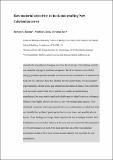Files in this item
Raw-material selectivity in hook-tool-crafting New Caledonian crows
Item metadata
| dc.contributor.author | Klump, Barbara Christina | |
| dc.contributor.author | Cantat, Mathieu | |
| dc.contributor.author | Rutz, Christian | |
| dc.date.accessioned | 2019-02-13T09:30:12Z | |
| dc.date.available | 2019-02-13T09:30:12Z | |
| dc.date.issued | 2019-02 | |
| dc.identifier | 257443850 | |
| dc.identifier | 8fcfb40a-83dd-4f9f-86b6-d3e8fc2bdc53 | |
| dc.identifier | 85062785546 | |
| dc.identifier | 000465400700009 | |
| dc.identifier.citation | Klump , B C , Cantat , M & Rutz , C 2019 , ' Raw-material selectivity in hook-tool-crafting New Caledonian crows ' , Biology Letters , vol. 15 , no. 2 , 20180836 . https://doi.org/10.1098/rsbl.2018.0836 | en |
| dc.identifier.issn | 1744-9561 | |
| dc.identifier.other | ORCID: /0000-0001-5187-7417/work/60427570 | |
| dc.identifier.uri | https://hdl.handle.net/10023/17049 | |
| dc.description | Funding: UK Biotechnology and Biological Sciences Research Council (BB/G023913/2) (CR). | en |
| dc.description.abstract | Animals that manufacture foraging tools face the challenge of identifying suitable raw materials among a multitude of options. New Caledonian crows exhibit strong population-specific material preferences for the manufacture of hooked stick tools, but it is unknown how they identify their favourite plants. We investigated experimentally whether crows pay attention to the stems of plants (from which the tools are made) and/or their leaves (which are usually discarded during manufacture but may enable rapid and reliable species identification at a distance). Subjects were highly selective in choice trials with multiple plant species. Two additional treatments with experimental leaf–stem combinations revealed that birds can identify their preferred plant species by its stems alone, and possibly also its leaves. These findings encourage future experiments that investigate whether New Caledonian crows attend to features of the stem that are required for the production of efficient hooked stick tools. Our study provides one of the most detailed assessments to date of how non-human animals identify raw materials for tool manufacture. | |
| dc.format.extent | 6 | |
| dc.format.extent | 4565950 | |
| dc.language.iso | eng | |
| dc.relation.ispartof | Biology Letters | en |
| dc.subject | Corvid | en |
| dc.subject | Corvus moneduloides | en |
| dc.subject | Material selectivity | en |
| dc.subject | Tool manufacture | en |
| dc.subject | Tool selection | en |
| dc.subject | Tool use | en |
| dc.subject | QH301 Biology | en |
| dc.subject | NDAS | en |
| dc.subject.lcc | QH301 | en |
| dc.title | Raw-material selectivity in hook-tool-crafting New Caledonian crows | en |
| dc.type | Journal article | en |
| dc.contributor.sponsor | BBSRC | en |
| dc.contributor.institution | University of St Andrews. School of Biology | en |
| dc.contributor.institution | University of St Andrews. Centre for Biological Diversity | en |
| dc.contributor.institution | University of St Andrews. Centre for Social Learning & Cognitive Evolution | en |
| dc.identifier.doi | https://doi.org/10.1098/rsbl.2018.0836 | |
| dc.description.status | Peer reviewed | en |
| dc.identifier.url | https://dx.doi.org/10.6084/m9.figshare.c.4381781 | en |
| dc.identifier.grantnumber | BB/G023913/2 | en |
This item appears in the following Collection(s)
Items in the St Andrews Research Repository are protected by copyright, with all rights reserved, unless otherwise indicated.

